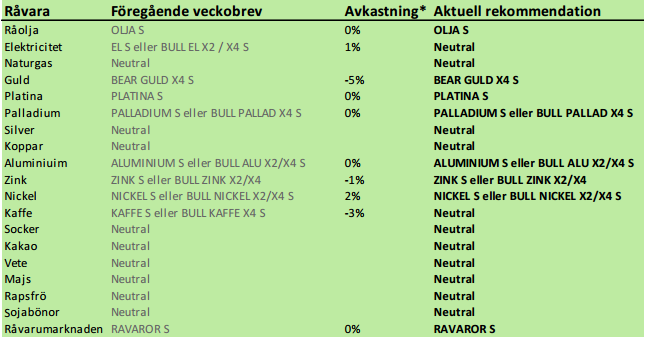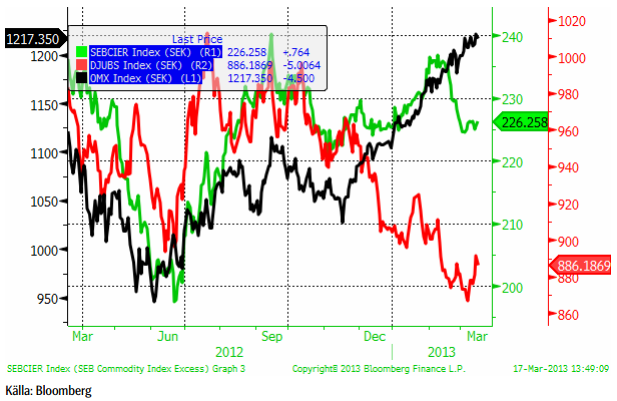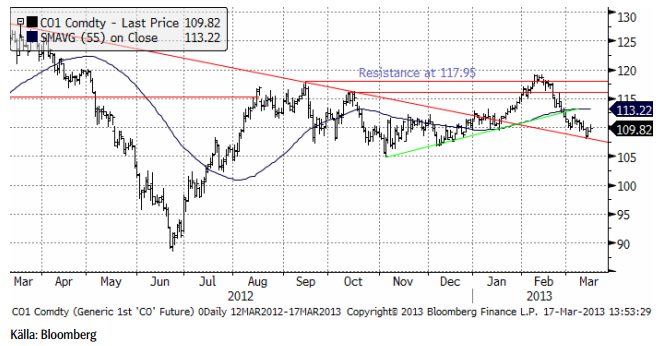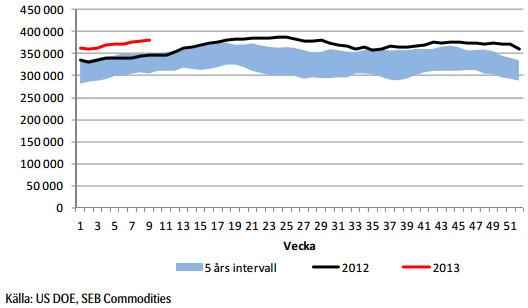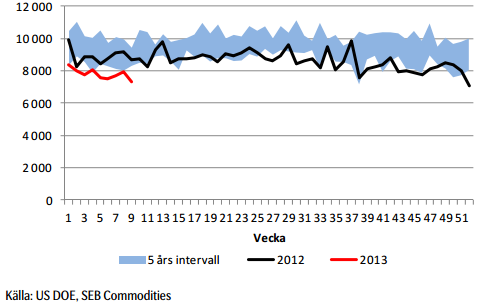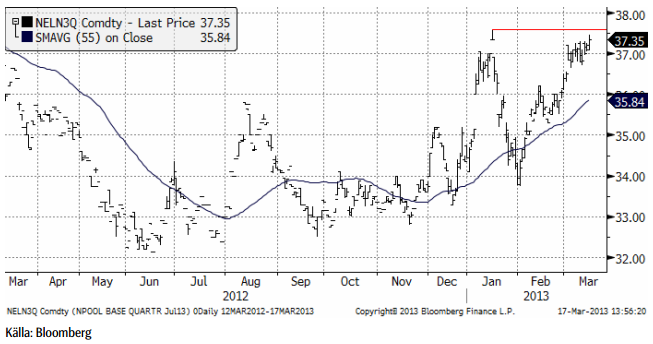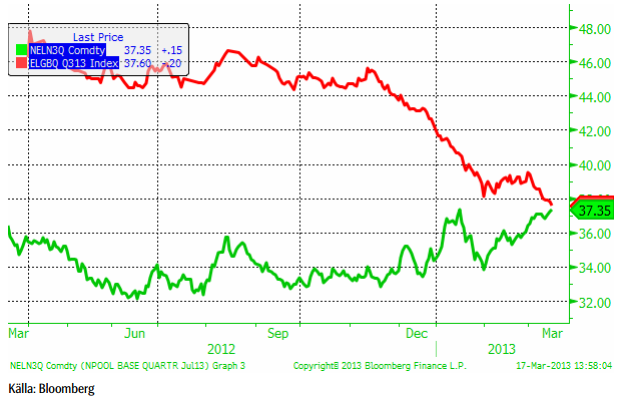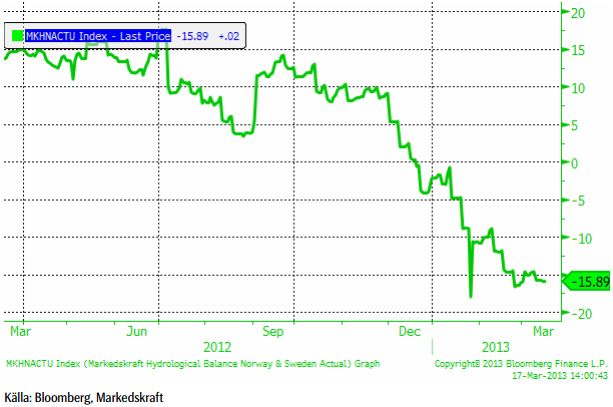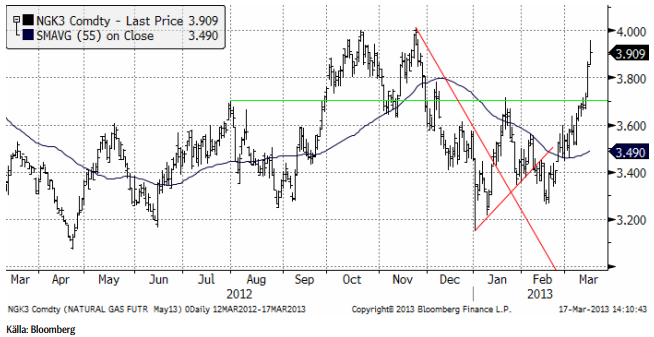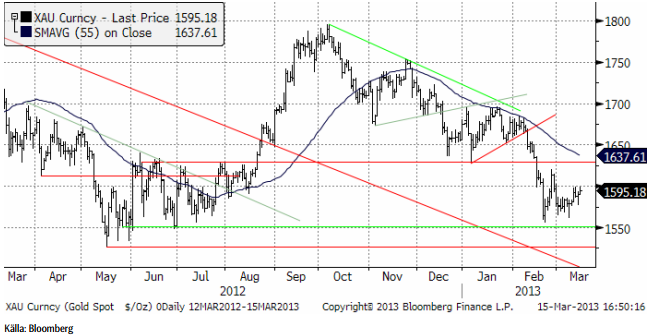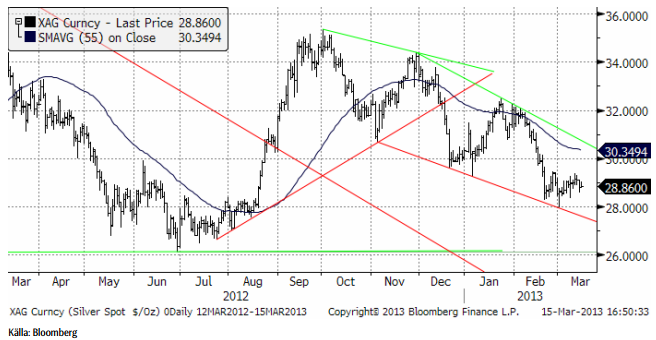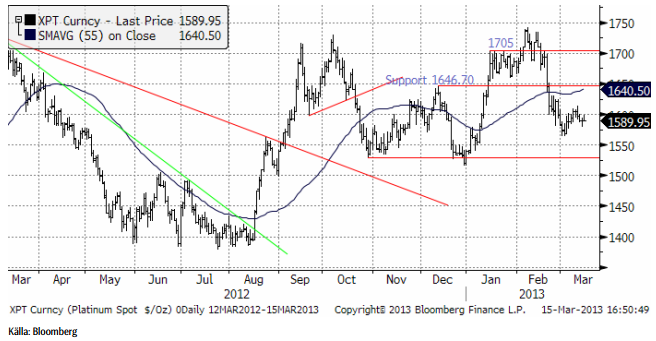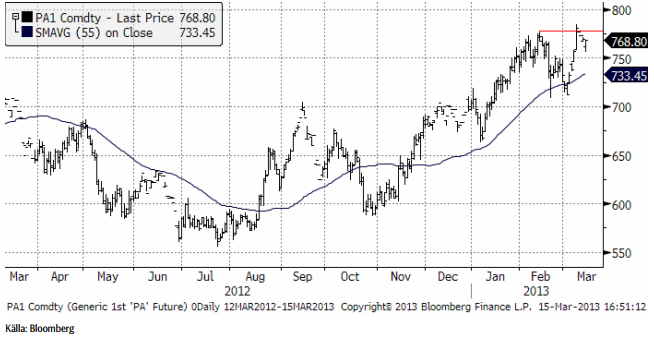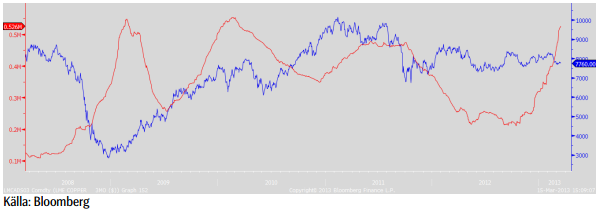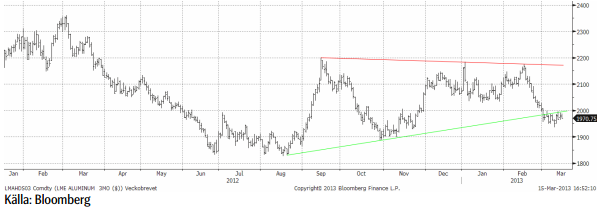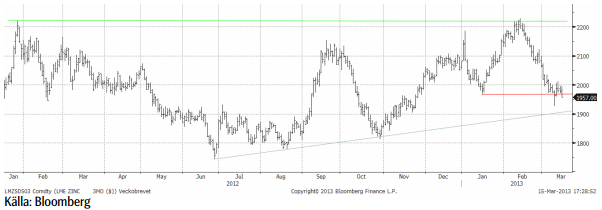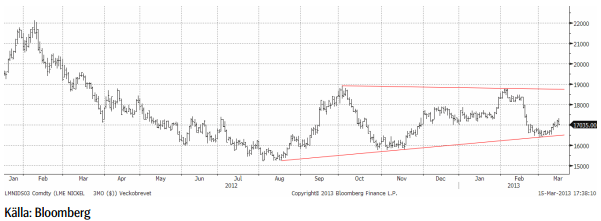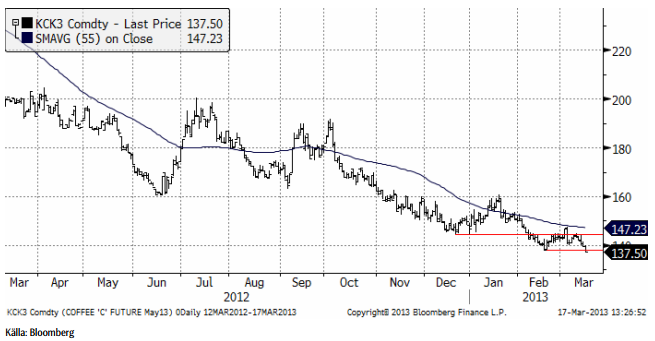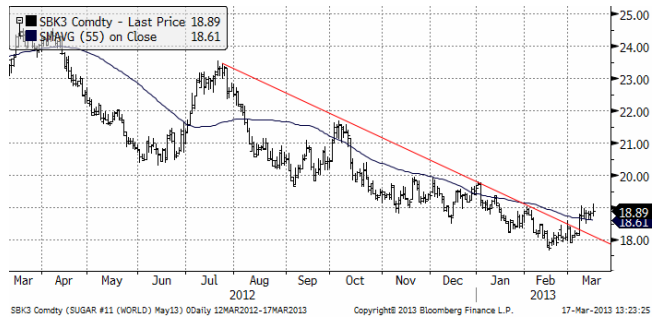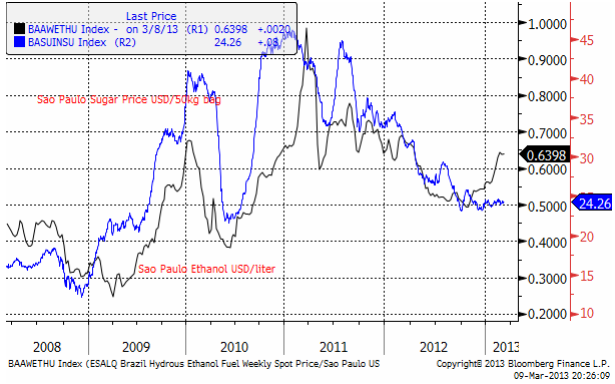Analys
SEB – Råvarukommentarer, 18 mars 2013

Rekommendationer
*) Avkastningen avser 1:1 råvarucertifikat där de ingår i rekommendationen. I den aktuella tabellen ovan har jag tagit prisförändringen den senaste veckan sedan det förra veckobrevet publicerades.
Inledning
Råvarumarknaden var ganska lugn och avvaktande förra veckan. Flera råvarumarknader har avslutat (?) en större prisrörelse och befinner sig i rekyl mot den tidigare trenden, som t ex majs, vete, ädelmetaller. Andra börjar närma sig psykologiskt viktiga nivåer, som t ex elektriciteten.
Den här veckan gör vi ett par ändringar av vår vy. Trots att det mesta fundamentalt pekar på att kaffepriset är lågt och borde kunna ligga högre går vi över till neutral rekommendation. Elmarknaden som vi haft köpt rekommendation på i flera månader väljer vi nu att också gå över till neutral rekommendation på. Priset börjar närma sig tidigare toppnotering och det tyska priset har fortsatt att falla.
Råvaruindex
I diagrammet nedan ser vi SEB:s råvaruindex (grön), OMX (svart) och DJUBS (röd), alla omräknade till svenska kronor. Vi ser att DJ UBS drabbats mycket av dess stora övervikt på jordbruksprodukter. SEB:s index har drabbats av detta också, men inte i lika stor utsträckning. Prisfallet på energi den senaste månaden har däremot tyngt indexet. Aktier har gått starkt sedan november. Den senaste månaden har råvaruindex sjunkit och aktier stigit.
Den som vill investera i indexet och den investeringsstrategi som ligger bakom kan läsa mer certifikatet RAVAROR S.
Råolja – Brent
Oljepriset har fortsatt att falla. I bankens senaste Oil Market report varnas för att den här svagheten kan komma att fortsätta
Lagren och lagerförändringarna i USA per den 8 mars ser vi nedan, enligt Department of Energy och American Petroleum Institute.
Nedan ser vi amerikanska råoljelager enligt DOE i tusen fat. Den svarta kurvan är 2012 års lagernivåer vecka för vecka och den lilla röda linjen är 2013 års nivå. Vi ser att lagernivåerna fortsätter att vara högre än de varit sedan 2007 för den här tiden på året.
Lagren ökar samtidigt som vi ser att importen av råolja till USA fortsätter att minska. I veckans statistik minskade importtakten ytterligare.
Vi rekommenderar köp av OLJA S, men inte av BULL OLJA S. Anledningen till denna skillnad och att vi rekommenderar köp av OLJA S är för att rabatten på terminerna innebär en stadig intäkt om ca 6% till 7% per år + ränta på kapitalet.
Elektricitet
Underliggande för SEB:s certifikat på el är det tredje kvartalets terminskontrakt. Det avser alltså vad det genomsnittliga spotpriset kommer att bli under juli, augusti och september. Vi ser kursdiagrammet för det senaste året nedan.
Nedanför ser vi prisutvecklingen för det tredje kvartalets tyska elpriskontrakt (röd) och Nord Pools tredje kvartalskontrakt (grön). Det tyska priset har fortsatt att falla och det nordiska att stiga. Det är nu bara 25 eurocent som skiljer priserna åt.
Det är en kall och torr vår gör sommaren kort, skrev Lars Wivallius år 1642. Den hydrologiska balansen för Nord Pools börsområde har sjunkit ytterligare från -14.66 TWh till -15.89 TWh.
Sammanfattningsvis. En lite otydlig situation. Priset för tredje kvartalet börjar närma sig den föregående toppen vid 37.60. Det brukar kunna locka fram säljordrar. Att det tyska priset samtidigt fortsätt att falla är också ett negativt tecken. Att priset på el skulle vara högre i vattenkraftsrika Norden än i Tyskland hör till ovanligheterna även om det förekommit. Det är svårt att rekommendera köp just nu, så vi går över till neutral i avvaktan på att se om priset tar ut toppen på 37.60.
Naturgas
Naturgasterminen på NYMEX (maj 2013) har handlats upp ordentligt och närmar sig 4 dollar, där priset vänt ner två gånger tidigare. Vi fortsätter att hålla oss neutralt till naturgasen.
Guld & Silver
Guldpriset rekylerade upp i veckan som gick. Frågan är nu om den senaste månadens konsolidering kommer att följas av ytterligare prisfall – förbi 1550 eller om marknaden kommer att söka över 1600 och upp mot 1650?
Situationen liknar den från 2008/09, när placerare sålde guld och köpte aktier. Vi har stora utflöden ur fonder med fysiskt guld. Samtidigt verkar guld bli mer populärt bland centralbanker. I veckan kom uppgifter om att den japanska centralbanken ska köpa mer guld. Det har i och för sig inte entydigt ett positivt signalvärde. Centralbanker storsålde under hela 70-talets guldprisuppgång. När de blev nettoköpare på 80-talet var boomen förbi. Konservativa och följande organisationer ligger alltså sent i cykeln – kanske så sent att de blir något av kontraindikatorer.
Nedan ser vi kursdiagrammet för silver i dollar per troy ounce. Även här har priset rört sig ”sidledes” den senaste månaden och bygger upp fallhöjd om priset ska följa den inslagna trenden nedåt.
Platina & Palladium
Den sydafrikanska randen föll till nya bottennivåer mot dollarn i veckan som gick. Det ökar lönsamheten för de pressade gruvbolagen och tynger därmed priset på platina.
Palladium som rusade förrförra veckan, har konsoliderat sin uppgång. Det är förmodligen ingen dum idé att köpa palladium nu.
Koppar
Kopparpriset stabiliserades i veckan och noteras i skrivandes stund ca 1 % högre från veckostarten. Vi har i de senaste veckobreven uttryckt en viss försiktighet gentemot koppar med hänvisning till ett förväntat skifte, från en ”kronisk” marknad i underskott, till mer balanserad. En del tecken tyder på att utbudet nu verkligen ökar. Vi har poängterad en ökad contango (terminspremie) på de närmsta terminerna, ökade smältlöner (till förmån för smältverken, vilket indikerar ökat gruvutbud). LME-lagret är en annan indikation (se grafen nedan) som nu uppgår till 525 tton, den högsta nivån på nästa 3 år. Lagerförändringarna samvarierar ganska väl med importen till Kina (som vi skrev om förra veckan), vilket således också är en negativ indikation.
Koppar pris/lager (pris blå linje/LME-lager röd linje)
Den tekniska bilden ger stöd till vår neutrala position. Vi är positiva till basmetaller på sikt men avvaktar bättre köptillfällen på koppar, alternativt väljer någon annan basmetall. Den stora triangelformationen börjar spela ut sin roll. Stödnivåer noteras vid 7600 och 7400. Nivån 7800 fungerar nu som motstånd.
Vi ser inte den stora potentialen på koppar på uppsidan just nu. Vi rekommenderar därför en fortsatt neutral position. För den som vill satsa på ett starkare tillväxtscenario (än konsensus) i Kina är koppar däremot alltid ett intressant alternativ.
Aluminium
Aluminiumpriset har till stor del följt kopparn under veckan, som avslutas med en positiv veckoförändring på ca 1 %. Som vi skrivit tidigare ligger aluminium väldigt ”fast” i ett relativt stort handelsintervall. Nivåer kring $1800-1900 utgör ur ett kostnadsperspektiv starkt stöd. Samtidigt lägger det stora utbudet ett ”tak” på nivåer kring $2300. Den senaste uppgången i februari mötte stora säljordrar från producenter som passade på att ”låsa” framtida priser, vilket satte press på marknaden. Nu när priserna fallit tillbaka ser vi stora intressen från köpsidan (fysiska förbrukare). För den ”trading-benägne” utgör det stora spannet goda vinstmöjligheter.
P.g.a. den låga prisnivån i relation till marginalkostnaden är aluminium köpvärd och vi ansluter den till köprekommendationerna.
Zink
Även zinken återhämtade sig med övriga basmetaller under veckans inledning men slutar veckan i princip oförändrad. Tekniska fonder har varit säljare och tryckt tillbaka marknaden vid varje återhämtningsförsök. Priset är nu nere på nivåer då marknaden bör få stöd av förväntningar om minskat utbud. Priset skär ned i kostnadskurvan och producenterna med de högsta kostnaderna förväntas minska produktionen om priserna ligger kvar under en lägre tid. Frågan är hur lång tid det tar. Vid tidigare nedgångar har marknaden börjat diskontera utbudseffekten vilket ger stöd till priset.
Tekniskt sett ser det svagt ut just nu och det finns risk för fortsatt press från tekniskt orienterade fonder. Det långsiktiga stödet kommer in kring $1900.
Placeringsförslaget från december med horisonten 3 månader kan summeras med en god utveckling inledningsvis. Under perioden steg priset till som högst $2250 (3 månaders LME). Vi är generellt positiva till basmetaller och återkommer eventuellt med ett nytt placeringsförslag på zink längre fram. Nu håller vi oss neutrala, och avvaktar i första hand utvecklingen nästa vecka.
Nickel
Efter den stora tillbakagången ser vi en tydlig stabilisering av priset. Ur ett kostnadsperspektiv börjar nickel bli en väldigt intressant köpkandidat. Marknaden är fortsatt tveksam till den fundamentala situationen. Vi har tidigare bl.a. hänvisat till kommentarer från fysiska aktörer som indikerar att ”det finns gott om nickel”, samtidigt som rapporter gör gällande att exporten av nickelmalm från Indonesien till Kina ökar igen, vilket riskerar att öka utbudet av s.k. Nickel Pig Iron i Kina (vilket i sin tur minskar efterfrågan på nickelbärande skrot och primärnickel). Det senare håller nu på att ”svänga om” då kinesiska producenter är snabba att ställa om produktionen. Det ger ett naturligt stöd till nickelmarknaden. Den tekniska bilden är väldigt tydlig, och marknaden vände ”där den skulle”. Priset är upp ca 3 % i veckan. Kortsiktigt finns risk/möjlighet för en tillbakagång. Om priset kommer ned mot $16500 igen är det köpläge.
Vi rekommenderar köp av NICKEL S eller BULL NICKEL X2 / X4 S för den som vill ta mer risk. Vi varnade för en rekyl, och den kom. Priset har fallit mer än ”befarat”, men är nu på väldigt attraktiva nivåer.
Kaffe
Kaffepriset (maj 2013) bröt i fredags innan stängning under det tekniska stödet och stängde på 137.50 cent per pund. Den fallande trenden har alltså liksom vintern i Sverige, ännu övertaget. Många har liksom jag trott att priset skulle vända upp snabbare. Kortsiktigt kan de som tar sig ur positionerna för att inte små förluster ska utveckla sig till större, få priset att falla ytterligare. På längre sikt ”borde” priset finna en botten snart och handla högre. Osäkerheten gäller mer tajmingen på den botten.
Vi går därmed över till neutral rekommendation på kaffe, eftersom vi befarar att det kan bli ytterligare prisnedgångar på kort sikt.
Socker
Sockerpriset (maj 2013) som brutit den nedåtgående trenden rent tekniskt fortsätter att testa 19 cent. I fredags försökte marknaden handla upp priset, men när dagen var slut stängde priset på 18.89 cent per pund. Vi har tidigare skrivit att priset på etanol i Brasilien har gått upp – vilket drar med sig priset på socker. Under majs (nedan) ser vi också att priset på etanol i USA har stigit stadigt, vilket är en faktor bakom stödet för majspriset. Det är också en stödjande faktor för sockerpriset.
Brasiliens regering vill öka användningen av etanol som drivmedel i landet. Många bilar i landet går att köra på både bensin och etanol, men priserna har varit sådana att folk har valt att tanka med bensin. Den ökade fokuseringen på etanol har fått priset att stiga, som vi ser i nedanstående diagram, som visar etanolpriset i Sao Paulo i USD per liter. Den blå linjen är priset på socker i samma delstat.
Vi ser att de två linjerna tenderar att hänga ihop och en uppgång i priset på etanol kan signalera att priset på socker också kommer att stiga framöver.
Finns tecken på att priset på socker är nära botten, men än så länge är pristrenden så stark att vi väljer att behålla neutral rekommendation ytterligare en vecka.
Vi tror att en trendvändning kan vara på gång. Prisuppgången till 19 cent, ett motstånd, är ett observandum.
[box]SEB Veckobrev Veckans råvarukommentar är producerat av SEB Merchant Banking och publiceras i samarbete och med tillstånd på Råvarumarknaden.se[/box]
Disclaimer
The information in this document has been compiled by SEB Merchant Banking, a division within Skandinaviska Enskilda Banken AB (publ) (“SEB”).
Opinions contained in this report represent the bank’s present opinion only and are subject to change without notice. All information contained in this report has been compiled in good faith from sources believed to be reliable. However, no representation or warranty, expressed or implied, is made with respect to the completeness or accuracy of its contents and the information is not to be relied upon as authoritative. Anyone considering taking actions based upon the content of this document is urged to base his or her investment decisions upon such investigations as he or she deems necessary. This document is being provided as information only, and no specific actions are being solicited as a result of it; to the extent permitted by law, no liability whatsoever is accepted for any direct or consequential loss arising from use of this document or its contents.
About SEB
SEB is a public company incorporated in Stockholm, Sweden, with limited liability. It is a participant at major Nordic and other European Regulated Markets and Multilateral Trading Facilities (as well as some non-European equivalent markets) for trading in financial instruments, such as markets operated by NASDAQ OMX, NYSE Euronext, London Stock Exchange, Deutsche Börse, Swiss Exchanges, Turquoise and Chi-X. SEB is authorized and regulated by Finansinspektionen in Sweden; it is authorized and subject to limited regulation by the Financial Services Authority for the conduct of designated investment business in the UK, and is subject to the provisions of relevant regulators in all other jurisdictions where SEB conducts operations. SEB Merchant Banking. All rights reserved.
Analys
Tightening fundamentals – bullish inventories from DOE

The latest weekly report from the US DOE showed a substantial drawdown across key petroleum categories, adding more upside potential to the fundamental picture.

Commercial crude inventories (excl. SPR) fell by 5.8 million barrels, bringing total inventories down to 415.1 million barrels. Now sitting 11% below the five-year seasonal norm and placed in the lowest 2015-2022 range (see picture below).
Product inventories also tightened further last week. Gasoline inventories declined by 2.1 million barrels, with reductions seen in both finished gasoline and blending components. Current gasoline levels are about 3% below the five-year average for this time of year.
Among products, the most notable move came in diesel, where inventories dropped by almost 4.1 million barrels, deepening the deficit to around 20% below seasonal norms – continuing to underscore the persistent supply tightness in diesel markets.
The only area of inventory growth was in propane/propylene, which posted a significant 5.1-million-barrel build and now stands 9% above the five-year average.
Total commercial petroleum inventories (crude plus refined products) declined by 4.2 million barrels on the week, reinforcing the overall tightening of US crude and products.


Analys
Bombs to ”ceasefire” in hours – Brent below $70

A classic case of “buy the rumor, sell the news” played out in oil markets, as Brent crude has dropped sharply – down nearly USD 10 per barrel since yesterday evening – following Iran’s retaliatory strike on a U.S. air base in Qatar. The immediate reaction was: “That was it?” The strike followed a carefully calibrated, non-escalatory playbook, avoiding direct threats to energy infrastructure or disruption of shipping through the Strait of Hormuz – thus calming worst-case fears.

After Monday morning’s sharp spike to USD 81.4 per barrel, triggered by the U.S. bombing of Iranian nuclear facilities, oil prices drifted sideways in anticipation of a potential Iranian response. That response came with advance warning and caused limited physical damage. Early this morning, both the U.S. President and Iranian state media announced a ceasefire, effectively placing a lid on the immediate conflict risk – at least for now.
As a result, Brent crude has now fallen by a total of USD 12 from Monday’s peak, currently trading around USD 69 per barrel.
Looking beyond geopolitics, the market will now shift its focus to the upcoming OPEC+ meeting in early July. Saudi Arabia’s decision to increase output earlier this year – despite falling prices – has drawn renewed attention considering recent developments. Some suggest this was a response to U.S. pressure to offset potential Iranian supply losses.
However, consensus is that the move was driven more by internal OPEC+ dynamics. After years of curbing production to support prices, Riyadh had grown frustrated with quota-busting by several members (notably Kazakhstan). With Saudi Arabia cutting up to 2 million barrels per day – roughly 2% of global supply – returns were diminishing, and the risk of losing market share was rising. The production increase is widely seen as an effort to reassert leadership and restore discipline within the group.
That said, the FT recently stated that, the Saudis remain wary of past missteps. In 2018, Riyadh ramped up output at Trump’s request ahead of Iran sanctions, only to see prices collapse when the U.S. granted broad waivers – triggering oversupply. Officials have reportedly made it clear they don’t intend to repeat that mistake.
The recent visit by President Trump to Saudi Arabia, which included agreements on AI, defense, and nuclear cooperation, suggests a broader strategic alignment. This has fueled speculation about a quiet “pump-for-politics” deal behind recent production moves.
Looking ahead, oil prices have now retraced the entire rally sparked by the June 13 Israel–Iran escalation. This retreat provides more political and policy space for both the U.S. and Saudi Arabia. Specifically, it makes it easier for Riyadh to scale back its three recent production hikes of 411,000 barrels each, potentially returning to more moderate increases of 137,000 barrels for August and September.
In short: with no major loss of Iranian supply to the market, OPEC+ – led by Saudi Arabia – no longer needs to compensate for a disruption that hasn’t materialized, especially not to please the U.S. at the cost of its own market strategy. As the Saudis themselves have signaled, they are unlikely to repeat previous mistakes.
Conclusion: With Brent now in the high USD 60s, buying oil looks fundamentally justified. The geopolitical premium has deflated, but tensions between Israel and Iran remain unresolved – and the risk of missteps and renewed escalation still lingers. In fact, even this morning, reports have emerged of renewed missile fire despite the declared “truce.” The path forward may be calmer – but it is far from stable.
Analys
A muted price reaction. Market looks relaxed, but it is still on edge waiting for what Iran will do

Brent crossed the 80-line this morning but quickly fell back assigning limited probability for Iran choosing to close the Strait of Hormuz. Brent traded in a range of USD 70.56 – 79.04/b last week as the market fluctuated between ”Iran wants a deal” and ”US is about to attack Iran”. At the end of the week though, Donald Trump managed to convince markets (and probably also Iran) that he would make a decision within two weeks. I.e. no imminent attack. Previously when when he has talked about ”making a decision within two weeks” he has often ended up doing nothing in the end. The oil market relaxed as a result and the week ended at USD 77.01/b which is just USD 6/b above the year to date average of USD 71/b.

Brent jumped to USD 81.4/b this morning, the highest since mid-January, but then quickly fell back to a current price of USD 78.2/b which is only up 1.5% versus the close on Friday. As such the market is pricing a fairly low probability that Iran will actually close the Strait of Hormuz. Probably because it will hurt Iranian oil exports as well as the global oil market.
It was however all smoke and mirrors. Deception. The US attacked Iran on Saturday. The attack involved 125 warplanes, submarines and surface warships and 14 bunker buster bombs were dropped on Iranian nuclear sites including Fordow, Natanz and Isfahan. In response the Iranian Parliament voted in support of closing the Strait of Hormuz where some 17 mb of crude and products is transported to the global market every day plus significant volumes of LNG. This is however merely an advise to the Supreme leader Ayatollah Ali Khamenei and the Supreme National Security Council which sits with the final and actual decision.
No supply of oil is lost yet. It is about the risk of Iran closing the Strait of Hormuz or not. So far not a single drop of oil supply has been lost to the global market. The price at the moment is all about the assessed risk of loss of supply. Will Iran choose to choke of the Strait of Hormuz or not? That is the big question. It would be painful for US consumers, for Donald Trump’s voter base, for the global economy but also for Iran and its population which relies on oil exports and income from selling oil out of that Strait as well. As such it is not a no-brainer choice for Iran to close the Strait for oil exports. And looking at the il price this morning it is clear that the oil market doesn’t assign a very high probability of it happening. It is however probably well within the capability of Iran to close the Strait off with rockets, mines, air-drones and possibly sea-drones. Just look at how Ukraine has been able to control and damage the Russian Black Sea fleet.
What to do about the highly enriched uranium which has gone missing? While the US and Israel can celebrate their destruction of Iranian nuclear facilities they are also scratching their heads over what to do with the lost Iranian nuclear material. Iran had 408 kg of highly enriched uranium (IAEA). Almost weapons grade. Enough for some 10 nuclear warheads. It seems to have been transported out of Fordow before the attack this weekend.
The market is still on edge. USD 80-something/b seems sensible while we wait. The oil market reaction to this weekend’s events is very muted so far. The market is still on edge awaiting what Iran will do. Because Iran will do something. But what and when? An oil price of 80-something seems like a sensible level until something do happen.
-

 Nyheter4 veckor sedan
Nyheter4 veckor sedanMahvie Minerals växlar spår – satsar fullt ut på guld
-

 Analys4 veckor sedan
Analys4 veckor sedanA muted price reaction. Market looks relaxed, but it is still on edge waiting for what Iran will do
-

 Nyheter3 veckor sedan
Nyheter3 veckor sedanJonas Lindvall är tillbaka med ett nytt oljebolag, Perthro, som ska börsnoteras
-

 Nyheter3 veckor sedan
Nyheter3 veckor sedanOljan, guldet och marknadens oroande tystnad
-

 Nyheter3 veckor sedan
Nyheter3 veckor sedanDomstolen ger klartecken till Lappland Guldprospektering
-

 Analys3 veckor sedan
Analys3 veckor sedanTightening fundamentals – bullish inventories from DOE
-

 Nyheter2 veckor sedan
Nyheter2 veckor sedanRyska staten siktar på att konfiskera en av landets största guldproducenter
-

 Nyheter2 veckor sedan
Nyheter2 veckor sedanSommarvädret styr elpriset i Sverige


